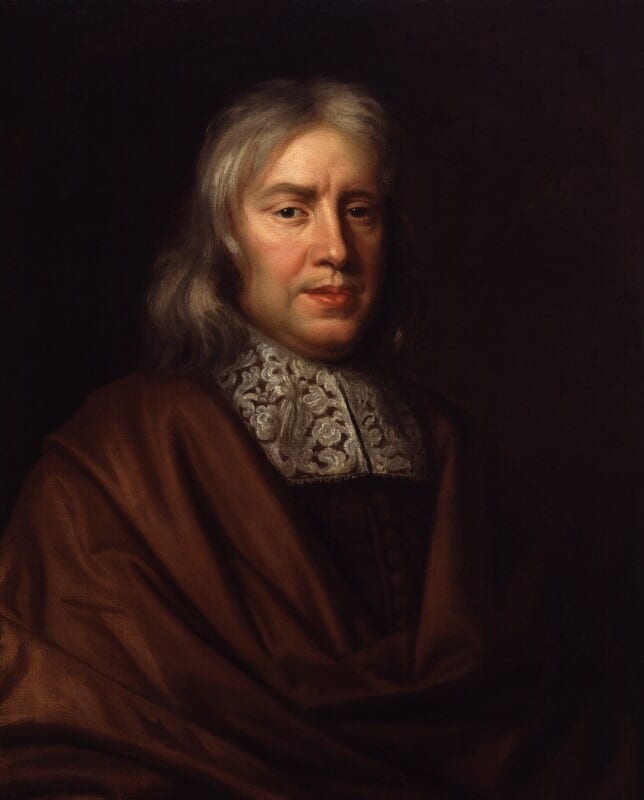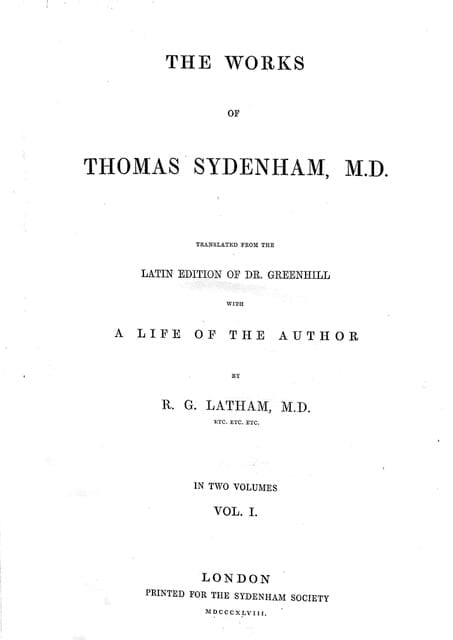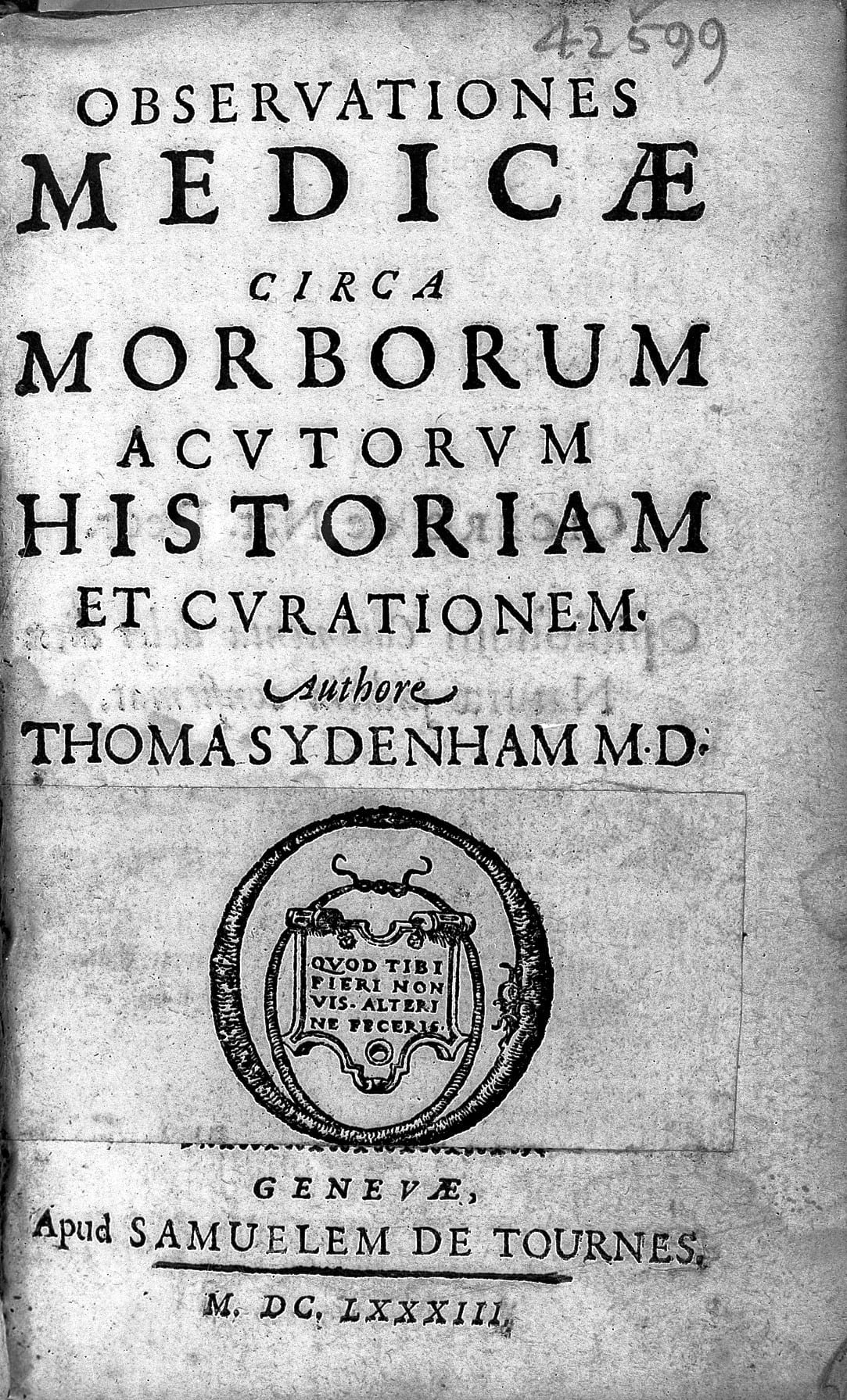JMS Pearce
East Yorks, UK
 |
| Fig 1. Thomas Sydenham. Abraham Blooteling after Mary Beale – portrait of Thomas Sydenham 8-B-47-Med Source |
Still Fever burns, and all her skill defies
Till Sydenham’s wisdom plays a double part,
Quells the disease and helps the failing Art.
-from a poem on plague by John Locke, 1668
From Hippocrates, “Father Of Medicine,” to William Osler, “Father Of Modern Medicine,” plaudits for doctors abound and venerate their varied virtues. Thomas Sydenham (1624–1689) (Fig 1), the illustrious English physician, was revered, although mainly after his death, as the “The English Hippocrates.”1 His epitaph Medicus in omne aevum nobilia [Noble physician of all ages] likewise proclaimed his high repute.
The Sydenhams were an ancient family, seated at Sydenham near Bridgewater. Thomas Sydenham was born in September 1624 in Wynford Eagle, Dorset, four years before William Harvey’s De motu cordis. He fought in the English civil war for Cromwell’s parliamentarians and there witnessed the treatment of his brother by Thomas Coxe, MD, FRCP. This sparked his desire to become a doctor. Latham’s introduction to his collected works (Fig 2)2 and Dewhurst’s erudite account3 provide detailed biographies and his writings.
In 1642, aged eighteen, he entered Magdalen Hall, Oxford, and left soon after for military service as a Parliamentarian. He returned to Magdalen Hall, but in October, 1647, advised by Thomas Coxe (PRCP, 1682), he transferred to Wadham College to read medicine, taking the degree of M.B. in April 1648. His ability was recognized when he was made Fellow of All Souls where Christopher Wren was his contemporary. It was almost thirty years later (1676) that he graduated as MD, not at Oxford, but at Pembroke Hall, Cambridge, where his eldest son was an undergraduate. When hostilities broke out again in 1648 he returned to army service. After an unsuccessful attempt to enter Cromwell’s Parliament as MP for Weymouth, he moved to King Street, Westminster to practice medicine in about 1661. There he wrote his earliest account of epidemic fevers in London.
On 25 June 1663, he was admitted Licentiate of the College of Physicians (LRCP) which licensed him to practice; but despite his doctorate, he was never appointed a Fellow of the Royal College of Physicians. According to Munk’s roll 1624-1689 Vol I: “. . . at Oxford he proceeded doctor [MD]; he was content, however, with the minor [sic] degree, and, as such, was, by the statutes of the College of Physicians, inadmissible as a Candidate, and, à fortiori, as a Fellow.” Sydenham was an éminence grise, who held neither public office in a hospital nor a university chair.4
The year 1666 saw the publication of his first book, dedicated to Robert Boyle, Methodus Curandi Febres, propriis observationibus superstructa, published in four sections in the Philosophical Transactions of the Royal Society: 1. Continued fevers, 2. The symptoms of continued fevers, 3. Intermittent fevers, 4. Smallpox.
The dedication includes an encomium to Robert Boyle, who greatly influenced his methods. A second edition in 1668 included an additional chapter on the plague, which was epidemic in London between 1645 and 1646; it contains Latin elegiacs that introduce the esteemed John Locke, “founder of analytical philosophy of the mind.” The third edition (1676) bore the new title Obsevationes Medicae, and was dedicated to Dr. Mapletoft and included copious new material. This was the year in which Sydenham took the degree of Doctor of Medicine at Cambridge.
For three months in 1677 he was laid low by hematuria and gout, an affliction he first experienced in 1649. Then followed a series of publications: Epistola Responsaria and Dissertatio Epistolaris describing smallpox, venereal disease, hysteria, and podagra (gout). His Tractatus de podagra et hydrope 1683 described dropsy and gout, to which he himself was a martyr.5 His account exemplifies his writings and sedulous clinical skills:
The victim goes to bed and sleeps in good health. About 2 o’clock in the morning, he is awakened by a severe pain in the great toe; more rarely in the heel, ankle or instep. This pain is like that of a dislocation, and yet the parts feel as if cold water were poured over them. Then follows chills and shiver and a little fever. The pain which at first moderate becomes more intense. With its intensity the chills and shivers increase.
 |
| Fig 2. Works of Sydenham |
After a time this comes to a full height, accommodating itself to the bones and ligaments of the tarsus and metatarsus. Now it is a violent stretching and tearing of the ligaments – now it is a gnawing pain and now a pressure and tightening. So exquisite and lively meanwhile is the feeling of the part affected, that it cannot bear the weight of bedclothes nor the jar of a person walking in the room . . . As to liquors, those are the best which neither sink to the weakness of water, nor rise to the generosity of wine . . . The old saw is that “if you drink wine you have the gout, and if you do not drink wine the gout will have you.”
These disquisitions were praised and thus published in Geneva, Amsterdam, and in other European cities. His best-known legacy is perhaps his notably brief account of chorea, which in 1686 in Schedula monitoria and in 1693 he described as “Saint Vitus’s dance,” but which subsequently became known as Sydenham’s chorea:2
Chorea sancti viti. This is a kind of convulsion, which attacks boys and girls from the tenth year to the time of puberty. It first shows itself by limping or unsteadiness in one of the legs, which the patient drags. The hand cannot be steady for a moment. It passes from one position to another by a convulsive movement, however, much the patient may strive to the contrary. Before he can raise a cup to his lips, he makes as many gesticulations as a mountebank; since he does not move in a straight line, but has his hand drawn aside by spasms, until by some good fortune he brings it at last to his mouth. He then gulps it off at once, so suddenly and so greedily as if he were trying to amuse the lookers-on. (Progressus integri 1686, cited by Latham2)
(Saint Vitus was a Sicilian, martyred in 303 AD. Those who failed to propitiate St. Vitus, patron saint of epileptics and of dancers, would be cursed by being forced to dance, most notably in the “dancing plague” of Strasbourg in 1518—almost certainly mass hysteria.)
Epidemics
Sydenham befriended his pupil, the physician and philosopher John Locke (1632 -1704); a number of Sydenham’s manuscripts are in Locke’s handwriting. Soon after the Restoration, persuaded by the natural philosopher and scientist Robert Boyle, he systematically began to investigate epidemic diseases6 using careful observations with accurate records and minimum speculation.7 These were founded on Boyle’s methods:
- Only accurate observations of natural phenomena of diseases will enable one to improve medicine.
- The route is by performing experimenta
- The work should be built on one’s own observations
In Sydenham’s time most London inhabitants were working people, artisans, laborers, servants, the casually employed, and the poor. Slowly there developed a population of the “middling sort”—people from businesses, merchants, and professions who lived comfortably. Infant mortality was high, deaths in childbearing frequent, nutrition and hygiene commonly inadequate; infections and the wounds of war comprised much of a doctor’s work. Sydenham lived through the epidemics of the plague of 1665, smallpox, and the great fire of London in 1666. His observations on epidemic infections in London from 1661-1675 were recorded in his Observationes medicae8 1676 (Fig 3), dedicated to John Mapletoft, which became the standard textbook for almost two centuries.
In this book Sydenham described scarlet fever and differentiated it from measles.6 He also introduced laudanum (alcoholic tincture of opium) into medical practice. He differentiated malaria from other fevers and was an early advocate of quinine, the active ingredient of Peruvian cinchona bark: “The Peruvian bark became my sheet-anchor; concerning which, in spite of the prejudices of many learned men . . . I may safely affirm that I have neither seen nor suspected any evil effects. . . .”
Sydenham prescribed iron (chalybeate)—a mixture of iron filings with extract of wormwood—in febris alba, chlorosis, or iron deficiency anemia; and used mercury inunction in syphilis. He provided a detailed description of hysterical symptoms (“one-sixth of all human maladies”), noting, “It resembles almost all the diseases poor mortals are inclinable to.” He recounted contemporary treatment and his personal opinions about the nature of the hysteria.9 In 1683 he included a section on plague in his Methodus curandi febres 1666. His most important works were Observationes Medicae (1676) in which he extended his appraisal of fevers, and his revised Opera Omnia10 and Opera universa.
 |
| Fig 3. Observationes Medicae circa Morborum Acutorum… Credit: Wellcome Collection. (CC BY 4.0) |
Practical observation not theory
Sydenham taught himself an empirical, utilitarian approach to medicine, focusing on the physical signs of disease and he was skeptical about the worth of pathology and theory.11
Physick says Sydenham, is not to bee learned by going to Universities, but hee is for taking apprentices; and says one had as good send a man to Oxford to learn shoemaking as practicing physick.3 p.17
Though a devotee of Hippocrates, in place of Hippocratic theories of imbalanced humors he insisted that specific diseases could be more accurately identified by meticulous, diacritical observations. A zealous puritan, Sydenham believed that natural processes governed by God were the cause of illnesses. Influenced by Hippocratic and Baconian teachings, he believed that disease was uniform and consistent; the same disease in different people evoked closely similar symptoms and signs. He disdained academic research as irrelevant to his practical clinical medicine. This limited his range, but at least prevented his making wild speculations, and helped him to avoid some of the pitfalls of his predecessors.11 Dewhurst regarded him “the greatest physician this country has ever produced.”
For an understanding of Sydenham’s checkered career, we have to visualize a staunchly independent man, who in both his military and medical roles undoubtedly was a rebel. Unsurprisingly, his uncompromising, novel, and critical attitudes provoked much hostility and rejection. Yet he found solace in many eminent friends and supporters, who included the distinguished Quaker, John Coakley Lettsom, Charles Goodall, Robert Boyle, John Locke, Walter Needham, Sir Hans Sloane, and Robert Hooke. By the end of the seventeenth century, his wisdom and remedies were recognized: he became the object of adulation.1 He was widely consulted by the titled and aristocracy.
A rebel physician he was, but his rebelliousness was of immense benefit to medicine. His was the egg from which subsequent clinical medicine was hatched. A biographer described him:
in his manner manly and simple, but, perhaps, somewhat rustic rather than polished and conciliatory-more the manner of a Dorsetshire squire and captain of horse than that of a courtly physician. He was essentially a man of action when most physicians were men of books.12
His character and practical common sense may be evident in selected quotations:
- “Of all the remedies it has pleased almighty God to give man to relieve his suffering, none is so universal and so efficacious as opium”
- “The arrival of a good clown exercises a more beneficial influence upon the health of a town than of twenty asses laden with drugs.”
- “I confidently affirm that the greater part of those who are supposed to have died of gout, have died of the medicine rather than the disease – a statement in which I am supported by observation.”
He married Mary Gee and had daughters and three sons; the eldest, William, practiced medicine.
His name is perpetuated in the Sydenham Society (1844-1857), later the New Sydenham Society (1858-1911). He was plagued by gout before he was thirty and had episodes of hematuria and renal colic. He died of renal failure secondary to gouty nephropathy on 29 December 1689, aged sixty-five, and was buried in St. James’ Church Westminster. His statue is at Oxford University Museum of Natural History. Perhaps it is ironic that three portraits and a marble bust are displayed in the Royal College of Physicians. And, on the dark stairway of St. James’ Church, his epitaph in Latin, placed by the Royal College in 1810, translates:
Near this place is buried Thomas Sydenham,
Renowned as physician through all ages.
He was born A.D. 1624.
He lived 65 years.
References
- Anstey P. The Creation of the English Hippocrates. Med Hist. 2011; 55(4): 457–478.
- Latham, R. G. The Works of Thomas Sydenham, translated from Latin ed’n of GA Greenhill. London, Sydenham Society,1848, 2 vols. Pp. 257-9. Reported in Medical Classics 1939;4:327-53
- Dewhurst K. Dr. Thomas Sydenham (1624-1689): His life and original writings. Wellcome Historical Medical Library,1966 https://wellcomecollection.org/works/g7rm55ay/items?langCode=eng&sierraId=b20086313&canvas=1
- Pearce JMS. Thomas Sydenham and Richard Bright on chorea. J Neurol Neurosurg Psychiatry. 1995; 58(3): 319.
- Jacobson A. The “English Hippocrates” and the disease of kings. Hektoen Int. Fall 2017.
- Sydenham T. Methodus curandi febres (London, 1666), repr. G.G. Meynell (ed.), (Folkestone: Winterdown Books, 1987). [Dedicated to Robert Boyle]
- Sydenham T. Opera universa…, Londinii Walteri Kettilby 1685.
- Sydenham T. Observationes medicae morborum acutorum historiam et curationem London. Kettilby. 1676.
- Pearce JMS. Sydenham on Hysteria. Eur Neurol. 2016; 76(3-4): 175‐181.
- Sydenham T. Opera Omnia Ed. GA Greenhill, London Sydenham Society, 1844. Original work: editio altera published 1685.
- Dewhurst K. Thomas Sydenham (1624 – 1689) Reformer of clinical medicine. Med Hist. 1962; 6(2): 101–118.
- Fischer WJ. Thomas Sydenham, The English Hippocrates (1624-1689). Canadian Medical Association Journal 1913;3:931-946.,
JMS PEARCE, MD, FRCP, is a retired neurologist and author with a particular interest in the history of science and medicine.
Summer 2020 | Sections | Physicians of Note

Leave a Reply